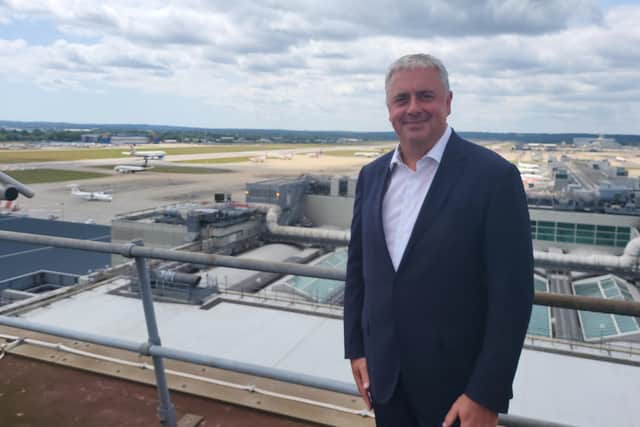'We are putting our money where our mouth is' - London Gatwick chief explains how they are mitigating environmental impact in £2.2 billion growth plans
and live on Freeview channel 276
The airport has today (Thursday, July 6) submitted an application - known as a Development Consent Order (DCO) - to the Planning Inspectorate (PINS), outlining its ambition to bring the airport’s existing Northern Runway into routine use alongside its Main Runway.
By investing in its long-term future, London Gatwick will also enhance the crucial economic role it plays by creating around 14,000 new jobs and injecting £1 billion into the region’s economy every year. This growth would come from increased tourism, trade, supply-chain, and other business opportunities.
Advertisement
Hide AdAdvertisement
Hide AdThe growth plans, which is estimated to cost £2.2 billion has been worked on since 2017 and after two consultations, the plans have now been submitted and they expect to hear by the end of 2024 whether they have been approved.


If approved, it is estimated the yearly movements (flights) will increase from approximately 286,000 a year (2019 figures) to 386,000 in 2030 meaning passenger numbers will increase from 48 million a year to 75 million.
But this week campaign groups the Gatwick Area Conservation Campaign (GACC) and CAGNE (Communities Against Gatwick Noise Emissions) have vowed to continue fighting the plans because of the impact it will have on the local and surrouding impact in terms of CO2 and noise emissions.
GACC say there is ‘no conceivable justification for the increased carbon emissions that would arise from expanding Gatwick, for which not mitigation realistically exists’ while CAGNE said: “We are all facing a climate emergency, and many have now decided not to fly because they are aware of what flying is doing to the climate, aviation being one of the biggest threats our planet faces.” You can read their full comments here.
Advertisement
Hide AdAdvertisement
Hide AdBut as part of the submission to PINS London Gatwick has also made some legally binding commitments, to ensure it controls noise levels and reduces carbon emissions under the airport’s direct control. And the airport London Gatwick recently announced a £250 million investment to accelerate its plan to be net zero for its own Scope 1 and 2 carbon emissions by 2030, 10 years earlier than previously planned and to commit to this as part of a Carbon Action Plan submitted with the application.
Mr Wingate told us: “We are putting our money where our mouth is with this commitment not only are we hoping that happens, it must happen.
"We put forward our proposals so they are inline with Government policies. We fundamentally believe that the proposals are inline with that policy so therefore as long as we have mad ethe correct assessments and mitigations we should be successful.
"Of course the campaign groups are an important voice, so we have listened to them carefully. We are confident on air quality, that none of our proposals will breach any of the legal limits on air quality, we are confident we will be water neutral on our developments with the work we do at the airport to reduce usage and from a noise perspective, that’s why we have said in the future the airport will be no noisier than it was in 2019 because the aircraft will get quieter.
Advertisement
Hide AdAdvertisement
Hide Ad"What we have also done is prove that our fuelling system is SAF enabled so it can take the Sustainable Aviation Fuel which is coming in over the next few years and we are also looking at how we have hydrogen facilities at the airport.”
A legally binding ‘noise envelope’ will commit to reducing noise over time. This commitment ensures that within nine years of the Northern Runway opening the airport’s operations will generate less noise than in 2019, when the airport last operated at full capacity. The Northern Runway will not be used routinely - in conjunction with the main runway – between 11om to 6pm each day. An industry leading noise insulation scheme would also see the numbers of eligible homes increase from the current 2,000 to 4,300.
And in regards to noise, Mr Wingate added: “The noise contour that we concern ourselves with, there are about 9,500 residents that live in that noise contour and as part of the proposals we are bringing forward in enhanced noise insulation solutions . So we we will roughly double the amount of houses to put in place noise insulation.”
The airport’s chief planning officer Tim Norwood believe they have done all they can to mitigate the environmental impacts in the proposal. He said: “What the examination process entails is for everybody to have their view on the project whether you are a business, you are employed by the airport, whether to support the proposals or you are campaign group that is worried about the environmental impacts, the six month examination period is your opportunity to put your views forward to the independent planning inspectorate.
Advertisement
Hide AdAdvertisement
Hide Ad“We know the economic benefits of this project are significant, there are 14,000 additional jobs for the local region, £1b a year being generated by wages and spending in the area so all of these benefits are huge for our region.
“We know and we fully acknowledge an airport brings environmental impacts as well and what we need to do and what we have done in our application, we have assed those environmental impacts and then developed mitigation strategies to limit and where possible reduce those impacts.”